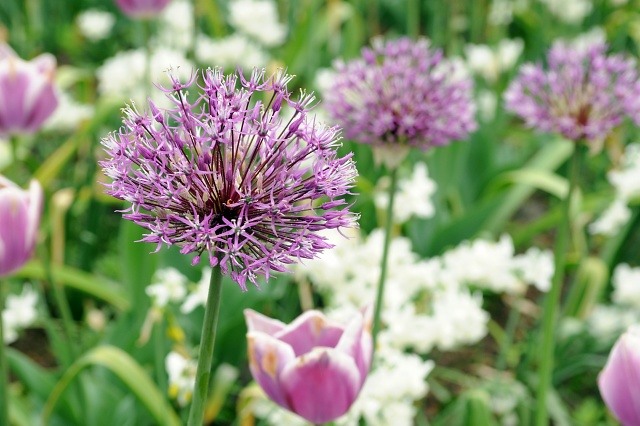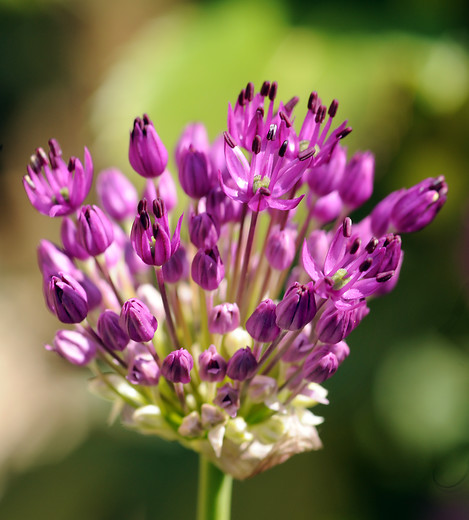Did you know that onions aren’t just good to eat but that the ornamental ones are pretty as well?
The large onion family has established itself not only in the kitchen. Some of them – the ornamental onions – are impressive features in the garden.
The Origins Of Ornamental Onions
Ornamental onions are endemic to Europe, Asia and the Middle East where they are found growing in the wild. The botanical name given to all onions is Allium; literally, this name means ‘sharp’, which also describes the flavour they add to foods prepared with them. Over the centuries, members of the Allium family have acquired several associations. The Victorians believed them to bring happiness and prosperity. The ancient Egyptians saw the scales of the onion as a symbol of eternity, so they used images of them on graves. The Romans named them ‘onions’ and ‘leeks’.

The Onion Family
The onions make up one big happy family. There are hundreds of species including the edible ones like onions, shallots, garlic, ramson and leeks. Nice to have such a big family – and they’re tasty, too! In addition to the edible onions, a much larger group steals the show in the garden. You’ll be amazed at their many different looks. They include some real giants as well as tiny cousins bearing delicate little flowers. Here is a list of them.
• Allium aflatunense is the most famous ornamental onion; each of the other members of the ornamental onion family is acquainted with this one. Its flower is made up of many small star-shaped flowers that together form a large ball.
• Allium ‘Ambassador’, with its large purple inflorescence and height of 150 cm, is the bold member of the family.
• Allium caeruleum is a real dreamer. Its sky-blue star-shaped flowers give it the look of a flower floating through the days.
• Allium christophii is the chic member of the family. The silvery pointed petals of its flowers that make up a ball 20 cm in diameter make a statement in the garden.
• Allium giganteum is the giant in the ornamental onion family. Its name is perfectly apt: its ball-shaped inflorescent is truly gigantic! You can’t help but notice this ornamental onion.
• Allium ‘Gladiator’ is an early eye-catcher. Not only does it quickly reach a height of at least a metre, but it is also the first of the huge ornamental onions to flower.
• Allium ‘Globemaster’ commands authority within the family. And no wonder because it has the longest flowering period, the most individual flowers, and is even the biggest of them all.
• Allium karataviense may be the little sister of the family but she’s not to be ignored. This ornamental onion may not reach a great height but its splendid cream to lilac flowers are truly impressive.
• Allium moly is the ‘little Miss Sunshine’ of this large family. Its delicate little yellow flowers make everyone smile.
• Allium ‘Mount Everest’ has a name that describes it perfectly. This one is white as snow and easily reaches a height of 120 cm!
• Allium neapolitanum is known for its elegant look; its family calls it ‘the bride’s onion’. Its individual sweet-smelling star-shaped flowers form a cluster of around 10 cm in diameter.
• Allium oreophilum enjoys cheering up the family with its pink flowers that protrude elegantly and every which way.
• Allium roseum has earned its nickname of ‘cutie pie’ from the rest of the family. Its little pale pink flowers couldn’t be called anything but adorable.
• Allium schubertii wants to be different from all the rest. Its little flowers on extra long stalks make it an eye-catcher.
• Allium sphaerocephalon has the nickname ‘Drumstick Onion’, so it’s the musical member of the family. Its purplish-red flowers are clustered tightly together to make a small ball that looks like a drumstick.
•Allium unifolium thinks it’s quite independent. Its pink star-shaped flowers look out over the world with nobody else’s help while the rest of its family secretly serves as support.

Good To Know
• Ornamental onions are even prettier if allowed to sparkle among perennials.
• Ornamental onions make wonderful long-lasting cut flowers.
• You don’t have to be bothered by an onion smell when using ornamental onions as cut flowers. Arranging the stems in ice-cold water will minimise this scent.
• Bees and butterflies are crazy about the flowers produced by ornamental onions.
• Some varieties are true giants: almost as tall as children.
• Many ornamental onion varieties will naturalise. This means that they will survive the winter, emerge again every year and even increase in number.
• You can find even more information about ornamental onions and other flower bulbs at www.bulb.com
Photos © iBulb





